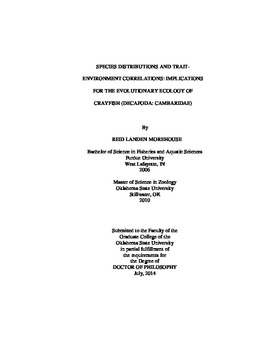| dc.description.abstract | Crayfish occur on every continent, except for Antarctica and Africa excluding Madagascar, and are a very diverse group of freshwater crustaceans with over 600 species. Crayfish are keystone species, ecosystems engineers, and make up the majority of invertebrate biomass in the systems they inhabit. In Oklahoma, there are 30 known species from six genera, with representatives from the three general ecological morphs that are defined by their burrowing behavior (burrowing types). In the first chapter, I provide a general overview and a synthesis of the questions addressed in my dissertation. The second chapter provides an in-depth account of Oklahoma's crayfish and their biology, including an illustrated dichotomous key for species identification, individual species descriptions with color photographs, and detailed distribution maps. This chapter provided the foundation for research on crayfish biology in my subsequent chapters. Specifically, my studies focused on the 27 epigean species of Oklahoma to address questions regarding the effects of climate change and land use on species distributions (Chapter 3), quantifying morphological variation among taxa to test of the role of evolutionary convergence among burrowing types (Chapter 4), and investigating whether and how trophic resource partitioning can mediate the coexistence of sympatric species (Chapter 5). In Chapter 3, my results suggested that different crayfish burrowing types were affected by distinct bioclimatic variables. Crayfish distributions, however, did not appear to be negatively affected by climate change, and habitat destruction is likely a driving factor in the decline of crayfish. Differences among burrowing types were also highlighted in Chapter 4, which indicated consistent morphological trait variation in species of the same burrowing type, irrespective of taxonomic affiliation, providing evidence for convergent evolution in crayfish morphology. Finally, in Chapter 5, stable isotope analyses indicated that some crayfish species pairs partition their food resources, but there is also evidence for overlap in dietary niches. Overall, my dissertation provides a foundation for the study of crayfish within Oklahoma and surrounding states and provides a basis of better understanding the evolutionary and ecological mechanisms that have lead to and contributed to maintaining crayfish diversity in North America. | |
